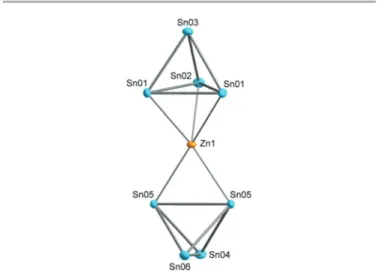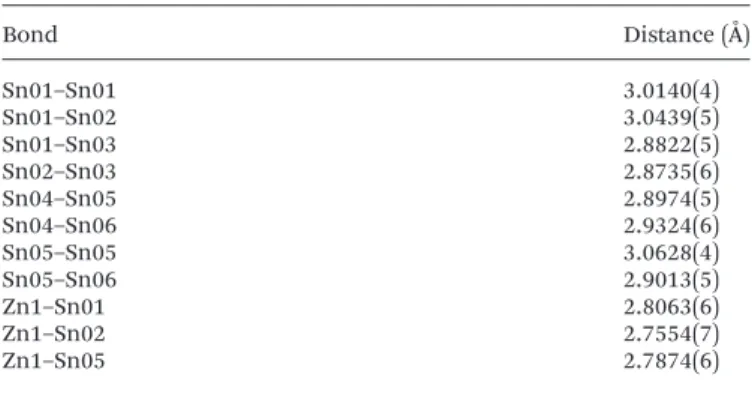Dalton
Transactions
COMMUNICATION
Cite this:Dalton Trans., 2013,42, 15548 Received 16th July 2013,
Accepted 12th September 2013 DOI: 10.1039/c3dt51932e www.rsc.org/dalton
Reaction of Sn
44−in liquid ammonia: the formation of Rb
6[( η
2-Sn
4)Zn( η
3-Sn
4)]·5NH
3†
Franziska Fendt,aCarina Koch,bStefanie Gärtneraand Nikolaus Korber*a
The reaction of Rb4Sn4with ZnPh2in liquid ammonia in the pres- ence of [2.2.2]-cryptand yielded crystals of Rb6[(η2-Sn4)Zn- (η3-Sn4)]·5NH3, which could be characterized by single crystal X-ray diffraction. This is thefirst example of a successful solution reac- tion of the highly charged tetrahedral Sn44−anions. The homo- leptic [E4ZnE4]6− complex (E = tetrel element) was previously known only for EvGe and Si/Ge.
Homoatomic polyanions of group 14 or 15 are a very fascinat- ing class of compounds as they can be considered as mole- cular, discrete building blocks of the main group elements.1 These polyanions are known from solid state materials, where the termZintlphases holds true.2Some of theZintlphases are soluble in appropriate solvents like ethylenediamine or liquid ammonia and undergo versatile chemical transformations with different ( post-) transition metal complexes as well as main group element compounds. These investigations have been limited to the well investigated E94− (EvSi–Pb) anions and a large number of reaction products can be found in the literature.1In contrast, only very little is known about the solu- tion behavior of the more highly reduced tetrahedral species E44−, which exist in the binaryZintlphases A4E4and A12E17.2–9 Only very few compounds are reported for derivatives of these anions. By reacting K6Rb6Si17or K14ZnGe16, respectively, with MesCu in liquid ammonia compounds including the [(MesCu)2E4]4− (EvSi10or Ge11) anion could be crystallized.
The use of mixed K12(Si,Ge)17precursor materials reacted with diphenylzinc resulted in the formation of K6ZnSi4.1(1)Ge3.9(1)· 11NH3.12 The lack of similar results for the heavier homo- logues tin and lead is conspicuous. A possible explanation
could be that the potential precursor materials A4E4were sup- posed to be insoluble until very recently.11
In preliminary investigations we were able to show that Rb4Sn4is soluble in anhydrous liquid ammonia, which is the best solvent for these very air and moisture sensitive com- pounds.13However,119Sn NMR experiments on ammonia solu- tions of Rb4Sn4 demonstrated that the use of pure liquid ammonia, without any further additives, exclusively yields Sn94−
clusters by fast rearrangement of the tetrahedral species in solution. Fortunately, the tetrahedranide anions can be stabi- lized in solution by the use of [2.2.2]-cryptand. We now employ the thus acquired knowledge to investigate the chemical reac- tions of Sn44− anions towards post-transition metal com- pounds. As a first result, we present here the formation of Rb6[(η2-Sn4)Zn(η3-Sn4)]·5NH3 (1) by reacting Rb4Sn4 with diphenylzinc in liquid ammonia in the presence of [2.2.2]-cryp- tand. The anionic moiety is represented by a [(Sn4)2Zn]6−(1a) unit, where a Zn2+cation is coordinated by two Sn44−anions (Fig. 1). The coordination of a post-transition metal (M) by two group 14 tetrahedra (E4) to form dimers (MvZn, EvGe or Si/
Ge),11,12,14one-dimensional strands (MvAu, EvSn or Pb)15,16
Fig. 1 Representation of the homoleptic complex1a. Anisotropic displacement ellipsoids are shown at 50% probability level.
†Electronic supplementary information (ESI) available. CCDC 939282 contains the supplementary crystallographic data for2. For ESI and crystallographic data in CIF or other electronic format see DOI: 10.1039/c3dt51932e
aInstitute of Inorganic Chemistry, University of Regensburg, Universitätsstr. 31, 93053 Regensburg, Germany. E-mail: nikolaus.korber@ur.de; Fax: +49 941 943 1812;
Tel: +49 941 943 4448
bInstitute of Organic Chemistry, University of Regensburg, Universitätsstr. 31, 93053 Regensburg, Germany
15548 |Dalton Trans., 2013,42, 15548–15550 This journal is © The Royal Society of Chemistry 2013
Published on 12 September 2013. Downloaded by Universitaetsbibliothek Regensburg on 03/08/2016 12:27:19.
View Article Online
View Journal | View Issue
or oligomers (MvCd, EvPb)17 is a well-known structural characteristic. A size effect seems to play a major role, as similar anionic moieties are reported for mixed alkali metal silicides and germanides, where the two tetrahedra are bridged by the smaller alkali metal.18–23Concerning zinc, such compounds which include the structural characteristic [E4ZnE4]6−are exclusively known for EvGe in solid state reac- tion generated compounds11,14or are obtained by reaction in solution for EvSi/Ge (mixed).12The tetrahedra show a versa- tile coordination behavior towards the central atom by using two triangular faces, two edges or the combination of one tri- angular face and one edge giving coordination numbers of four to six for the Zn2+cation (Table 1). It has to be noted that in the herein presented compound the junction of a ( post-) transition metal and Sn44−in general succeeded for the first time, and concerning zinc no comparable material is known either from solid state/melt reactions or from solution experi- ments. With respect to the interaction of tinZintlclusters and zinc,closo-[Sn9ZnR]3−(R = Ph, Mes,iPr) containing compounds are the only reported materials.24,25
The asymmetric unit of1consists of six tin atoms, one Zn atom, six Rb cations and four ammonia molecules.‡Several of the atoms are located on special position 4i of space groupI2/m (four tin atoms, the Zn atom, five Rb cations and three nitro- gen atoms). The Rb atom on the general position shows a site occupancy factor of 0.5, so that the electron count is balanced and gives a charge of minus six for the1aunit, in agreement with the formulation as Sn44− and Zn2+ions. In this anionic moiety, two Sn44−tetrahedra coordinate to the Zn2+cation and form a homoleptic complex. One triangular face of the first tetrahedron coordinates to the Zn atom; additionally one edge of the second tetrahedron coordinates in aη2-like fashion, which gives a total coordination number of five for the Zn atom. The same coordination number is observed in the related germa- nium compound A14ZnGe16. The Sn–Sn bond lengths of the triangular face respectively edge which are capped by Zn2+are significantly elongated compared to uncoordinated Sn44−
anions in solvate structures. The remaining Sn–Sn distances show the expected values for this class of compounds.26The Sn–Zn distances lie between 2.7554(7) Å and 2.8063(6) Å and therefore are very close to the values of the [Sn9ZnR]3− com- pounds (dAv(Sn–Zn) = 2.78 Å).24,25Fig. 1 shows1a, and the rele- vant distances are given in Table 2.
As the asymmetric unit consists of six tin atoms, four of which are located in special positions, each tetrahedron only shows four instead of six unique distances. The coordination sphere of the anion is completed by 16 Rb+cations at Rb–Sn
distances between 3.685(7) Å and 4.3798(3) Å (the discrepancy in the accuracy of the bond distances arises due to modeling some of the Rb positions with fractional occupancies) which interconnect the 1a anions to form a three dimensional network of cations and anions. The coordination sphere of the Rb atoms is saturated by two to three ammonia molecules at distances between 2.90(4) Å and 4.036(7) Å. Considering the Rb–ammonia network within the given distances, one dimen- sional strands along the crystallographic b-axis can be described, which are interconnected due to the Rb+–Sn44−
interaction, resulting in a three dimensional network of cations, anions and ammonia molecules.
According to our stoichiometric approach to Rb4Sn4: ZnPh2: [2.2.2]-crypt of 1 : 1 : 1 one would expect unreacted ZnPh2, benzene and [2.2.2]-cryptand to remain in solution. In contrast, the results of 13C and 1H,13C HSQC NMR investi- gations showed only the presence of benzene and cryptand.
Careful examination of the reaction precipitate showed the presence of further crystals, very similar in shape and color to those of1. Single crystal X-ray determination showed the com- pound to be a zincate with the composition (Rb@crypt)- ZnPh3·NH3 (2), which contains the well-known zincate anion [ZnPh3]−.27This allows for the remaining phenyl substituents as well as the excessive ZnPh2. The requirement of excess ZnPh2needs to be proven. No bulk characterization of1was possible due to fast and irreversible decomposition at tempera- tures above−20 °C. Despite much effort, no119Sn signal could be detected so far, which probably indicates low concen- trations or high fluxonality of 1 in solution. Similar obser- vations were previously reported by other groups.†24
Conclusions
We present here the first successful chemical transformation of the highly charged tinZintl anions Sn44−using the binary solid state material Rb4Sn4, [2.2.2]-cryptand and diphenylzinc in liquid ammonia solution. The presence of these anions in solution could be proven only very recently; the herein shown possibility of reacting them may open the door to a versatile solution chemistry of tetrahedral tinZintlanions Sn44−.
Table 2 Selected bond lengths for1a
Bond Distance (Å)
Sn01–Sn01 3.0140(4)
Sn01–Sn02 3.0439(5)
Sn01–Sn03 2.8822(5)
Sn02–Sn03 2.8735(6)
Sn04–Sn05 2.8974(5)
Sn04–Sn06 2.9324(6)
Sn05–Sn05 3.0628(4)
Sn05–Sn06 2.9013(5)
Zn1–Sn01 2.8063(6)
Zn1–Sn02 2.7554(7)
Zn1–Sn05 2.7874(6)
Table 1 Zn2+linked group 14 tetrahedra show different coordination numbers of Zn2+
Compound Anion CN(Zn2+)
Cs6Ge8Zn14 [(η3-Ge4)-Zn(η3-Ge4)]6− 6 A14ZnGe16(A = K, Rb)11 [(η2-Ge4)-Zn(η3-Ge4)]6− 5 K6Zn(Si,Ge)8·11NH312 [(η2-(Si,Ge)4)-Zn(η2-(Si,Ge)4)]6− 4 Rb6ZnSn8·5NH3 [(η2-Sn4)-Zn(η3-Sn4)]6− 5
Dalton Transactions Communication
This journal is © The Royal Society of Chemistry 2013 Dalton Trans., 2013,42, 15548–15550 | 15549
Published on 12 September 2013. Downloaded by Universitaetsbibliothek Regensburg on 03/08/2016 12:27:19.
View Article Online
Notes and references
‡Further details of the crystal structure investigation of1may be obtained from Fachinformationszentrum Karlsruhe, 76344 Eggenstein-Leopoldshafen, Germany (fax: (+49)7247-808-666; e-mail: crysdata(at)fiz-karlsruhe(dot)de, http://www.fiz-karlsruhe.de/request_for_deposited_data.html) on quoting the deposition number CSD 426039.
1 S. Scharfe, F. Kraus, S. Stegmaier, A. Schier and T. F. Fässler,Angew. Chem., Int. Ed., 2011,50, 3630–3670.
2 S. Gärtner and N. Korber, inZintl Ions Principles and Recent Developments, ed. T. F. Fässler, Springer-Verlag, Berlin Heidelberg, Germany, 2011, vol. 140, ch. 2, pp. 25–56.
3 H. G. von Schnering, M. Schwarz, J.-H. Chang, K. Peters, E.-M. Peters and R. Nesper, Z. Kristallogr. - New Cryst.
Struct., 2005,220, 525–527.
4 T. Goebel, Y. Prots and F. Haarmann, Z. Kristallogr. - New Cryst. Struct., 2008,223, 187–188.
5 H. G. von Schnering, J. Llanos, J. H. Chang, K. Peters, E. M. Peters and R. Nesper, Z. Kristallogr. - New Cryst.
Struct., 2005,220, 324–326.
6 Y. Grin, M. Baitinger, R. Kniep and H. G. von Schner- ing, Z. Kristallogr. - New Cryst. Struct., 1999, 214, 453–454.
7 M. Baitinger, Y. Grin, H. G. von Schnering and R. Kniep, Z. Kristallogr. - New Cryst. Struct., 1999, 457–458.
8 R. E. Marsh and D. P. Shoemaker, Acta Crystallogr., 1953, 197–205.
9 C. Hoch, M. Wendorffand C. Röhr,J. Alloys Compd., 2003, 361, 206–221.
10 M. Waibel, F. Kraus, S. Scharfe, B. Wahl and T. F. Fässler, Angew. Chem., Int. Ed., 2010,49, 6611–6615.
11 S. Stegmaier, M. Waibel, A. Henze, L. A. Jantke, A. J. Karttunen and T. F. Fässler,J. Am. Chem. Soc., 2012,134, 14450–14460.
12 M. Waibel, T. Henneberger, L. A. Jantke and T. F. Fässler, Chem. Commun., 2012,48, 8676–8678.
13 M. Neumeier, F. Fendt, S. Gärtner, C. Koch, T. Gärtner, N. Korber and R. M. Gschwind, Angew. Chem., Int. Ed., 2013,52, 4483–4486.
14 V. Queneau and S. C. Sevov,J. Am. Chem. Soc., 1997,119, 8109–8110.
15 U. Zachwieja and M. Wlodarski,Z. Anorg. Allg. Chem., 2004, 630, 993–997.
16 U. Zachwieja, J. Müller and J. Wlodarski, Z. Anorg. Allg.
Chem., 1998,624, 853–858.
17 E. Todorov and S. C. Sevov,Angew. Chem., Int. Ed., 1999,38, 1775–1777.
18 M. Schwarz, Dissertation Universität Stuttgart, 1987.
19 H. G. v. Schnering, M. Schwarz and R. Nesper, Angew.
Chem., Int. Ed. Engl., 1986,98, 558.
20 T. Goebel and F. Haarmann,Z. Kristallogr. Suppl. 29, 2009, 132.
21 T. Goebel and F. Haarmann, Z. Anorg. Allg. Chem., 2008, 634, 2040.
22 T. Goebel, Y. Prots, A. Ormeci, O. Pecher and F. Haarmann, Z. Anorg. Allg. Chem., 2011,637, 1982–1991.
23 T. Goebel, P. Jeglic and F. Haarmann,Z. Kristallogr. Suppl., 2008,28, 18–20.
24 B. B. Zhou, M. S. Denning, C. Jones and J. M. Goicoechea, Dalton Trans., 2009, 1571–1578.
25 J. M. Goicoechea and S. C. Sevov,Organometallics, 2006,25, 4530–4536.
26 K. Wiesler, K. Brandl, A. Fleischmann and N. Korber, Z. Anorg. Allg. Chem., 2009,635, 508–512.
27 M. Krieger, G. Geiseler, K. Harms, J. Merle, W. Massa and K. Dehnicke,Z. Anorg. Allg. Chem., 1998,624, 1387–1388.
Communication Dalton Transactions
15550 |Dalton Trans., 2013,42, 15548–15550 This journal is © The Royal Society of Chemistry 2013
Published on 12 September 2013. Downloaded by Universitaetsbibliothek Regensburg on 03/08/2016 12:27:19.
View Article Online

